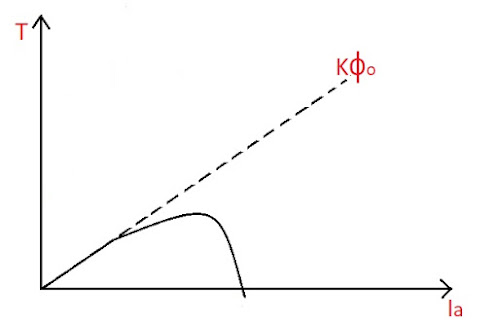Cumulatively Compound Motor
Torque-Armature Current Characteristics
The flux in a cumulatively compound machine will be function of sum of field flux and armature flux.
T = K Ⲫ Ia = K Ia f ( Nse Ia + Nsh If ) ,
Nsh = Nf = number of turns in shunt field winding
Nse = number of turns in series field winding
f = Frequency
There can be two cases depending upon whether Series Flux dominates or Shunt Flux dominates.
 |
| ( for strong field flux ) |
 |
| ( for weak field flux) |
For Strong Shunt Field, the machine behaves as a Shunt Machine but at higher values of Armature Current the series flux dominates and characteristics become similar to Series Excited Machine.
For Weak Shunt Field, series flux dominates and machine behaves as a Series Excited DC Motor.
Speed-Armature Current Characteristics
Ea = Vs - Ia ( Ra + Rse )
K Ⲫ N = Vs - Ia ( Ra + Rse )
Speed, N = [Vs - Ia ( Ra + Rse )] / [K f ( Nse Ia + Nsh If )]
Again for Weak Shunt Field, the characteristics are similar to Series Excited Machine and for Strong Shunt Field, the characteristics will be similar to Shunt Excited Machine.
 |
| ( for weak field flux ) |
 |
| ( for strong field flux ) |
Speed-Torque Characteristics
The Speed-Torque Characteristics for a Cumulatively Compound Machine looks as shown below,
 |
| ( for weak field flux ) |
 |
| ( for strong field flux ) |
Differentially Compounded Motor
In a differentially compounded motor the series flux will oppose the shunt field flux and thus the flux varies with armature current as shown below,
 |
| ( differentially compounded motor ) |
For higher values of Current the flux may even become negative i.e. it will reverse its direction which will cause reversal in direction of rotation and torque.
Torque-Armature Current Characteristics
For weak shunt field the flux reversal takes place at small armature current itself and for strong field flux the flux reversal requires larger amount of Armature Current as shown below,
 |
| (for weak field flux) |
 |
| (for strong field flux) |
Hence, for differentially compounded machine the characteristics are similar for Strong Shunt Field and Weak Shunt Field and the only difference lies in Armature Current required for flux reversal.
Speed-Armature Current Characteristics
Initially, for low values of Armature Current the Shunt Flux dominates and speed decreases as Armature Current increases due to decrease in induced emf but as armature current increases above a certain value series field dominates. This causes reduction in flux and thus speed increases as speed is inversely proportional to flux.
This is only DC Motor which can have zero speed regulation. But because of unstable runaway, we do not use this motor.
Speed-Torque Characteristics
These characteristics are similar to Speed-Armature Current Characteristics.




Comments
Post a Comment